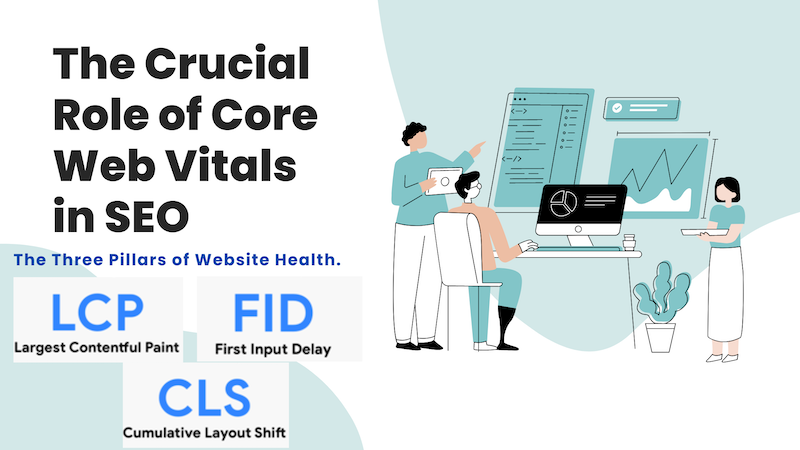In the ever-evolving landscape of SEO, staying ahead of the curve is essential for digital marketers and website owners. One of the latest game-changers in the SEO realm is the introduction of Core Web Vitals by Google.
These metrics are not just another set of criteria; they represent a fundamental shift in how search engines evaluate and prioritize user experience. In this comprehensive guide, we'll delve into the impact of Core Web Vitals on SEO and provide actionable insights on optimizing your website for these crucial metrics.
Understanding Core Web Vitals - The Three Pillars of Website Health:
1. Largest Contentful Paint (LCP)
LCP measures the time it takes for the main content on a page to load. Google considers a good LCP to be under 2.5 seconds. A fast-loading page contributes significantly to a positive user experience, and, as a result, it is favored by search engines.
2. First Input Delay (FID) (In March 2024, the Chrome team will replace the FID (First Input Delay) metric in Core Web Vitals with INP (Interaction to Next Paint)
FID gauges the time it takes for a page to become interactive. It assesses how quickly users can interact with elements on the page, such as clicking a button or filling out a form. An FID of under 100 milliseconds is considered optimal.
In May 2023 Google published a blog https://developers.google.com/search/blog/2023/05/introducing-inp stating After a year of testing and gathering feedback from the community, the Chrome team will decide to promote INP as the new Core Web Vitals metric for responsiveness, effective March 2024, replacing FID.
Rather than only measuring the first interaction, INP takes all interactions into account, reporting one of the slowest over the entire lifetime of the page. And, rather than only measuring the delay portion, INP measures the full duration from the start of the interaction, through the event handler, and until the browser is able to paint the next frame.
Hence, Interaction to Next Paint. These implementation details make INP a much more comprehensive measure of user-perceived responsiveness than FID.
The Chrome team's blog post explains this change and the reasoning behind the new metric in more detail. , the Chrome team will replace the FID (First Input Delay) metric in Core Web Vitals with INP (Interaction to Next Paint). This metric will measure responsiveness.
3. Cumulative Layout Shift (CLS)
CLS evaluates the visual stability of a page. It measures how much elements on a page shift or move during the loading process. A lower CLS score, indicating minimal unexpected layout shifts, is preferable for a seamless user experience.
The Impact on SEO Rankings:
Google has officially stated that Core Web Vitals are now a part of its ranking factors. This means that websites providing a better user experience, as measured by these vitals, are likely to receive a boost in search rankings. Ignoring Core Web Vitals could lead to a drop in visibility and organic traffic, as search engines increasingly prioritize user-centric metrics.
Practical Tips for Optimizing Core Web Vitals
Now that we understand the significance of Core Web Vitals, let's explore actionable strategies to optimize your website and ensure a positive user experience.
1. Optimize Images and Videos
Large media files contribute significantly to slow loading times. Compress and optimize images and videos to reduce their file sizes without compromising quality. Utilize modern image formats and lazy loading to ensure a faster loading experience for users.
2. Leverage Browser Caching
Browser caching allows frequently visited elements of your website to be stored locally on a user's device. This reduces the need for repeated downloads, leading to faster loading times. Configure your server to set appropriate caching headers for static resources.
3. Prioritize Critical Rendering Path
Ensure that your website's critical resources are loaded first. This includes stylesheets, scripts, and essential images. Prioritizing these elements can significantly improve LCP and overall page loading speed.
4. Minimize Server Response Time
A quick server response time is crucial for a fast-loading website. Optimize your server configuration, utilize Content Delivery Networks (CDNs), and consider upgrading your hosting plan if needed to minimize server response time.
5. Eliminate Render-Blocking JavaScript
JavaScript can be a major culprit in slowing down a website's rendering. Identify and eliminate unnecessary or render-blocking JavaScript to enhance FID and overall interactivity.
6. Implement Responsive Design
Ensure your website is mobile-friendly with a responsive design. A large portion of internet users access websites through mobile devices, and a responsive design is key to providing a positive user experience on various screen sizes.
7. Monitor and Address Layout Shifts
To minimize CLS, carefully design and test your website to prevent elements from unexpectedly shifting during loading. Regularly monitor your site's layout shifts and make adjustments as needed.
Tools and Resources for Core Web Vitals Monitoring:
Google provides several tools to help you monitor and optimize your Core Web Vitals:
• PageSpeed Insights:
This free tool analyzes your website and provides actionable recommendations for improvement.
• Search Console:
Google Search Console tracks your website's Core Web Vitals performance and reports any issues that might impact your ranking.
• Chrome DevTools:
This built-in browser tool offers detailed insights into your website's performance, including Core Web Vitals data.
Core Web Vitals have become a crucial factor in the SEO landscape, directly impacting search rankings. By understanding and optimizing for these metrics, website owners can not only improve their search visibility but also enhance the overall user experience. Keep abreast of the latest developments in SEO best practices and make Core Web Vitals optimization a priority for sustained online success.
But remember, Core Web Vitals are just one part of the SEO puzzle. While optimizing for these metrics is crucial, it's essential to remember that providing a truly exceptional user experience goes beyond numbers. Focus on creating high-quality content, structuring your website logically, and prioritizing accessibility for all users.
SEO is a dynamic field, and staying ahead requires a commitment to ongoing learning and adaptation. As you implement these strategies, continually monitor your website's performance and be prepared to refine your approach based on emerging trends and updates in search engine algorithms. With Core Web Vitals optimization, you're not just improving your search rankings; you're building a foundation for a user-centric digital presence.
January 31, 2024





